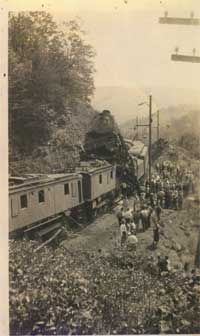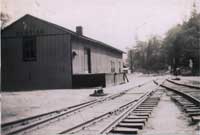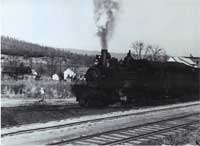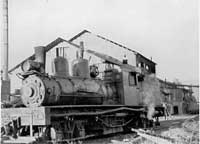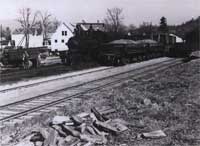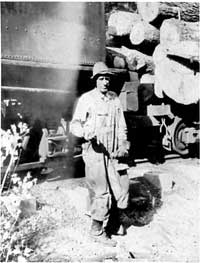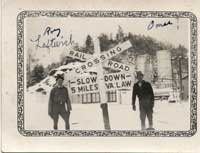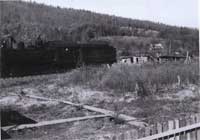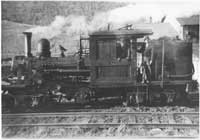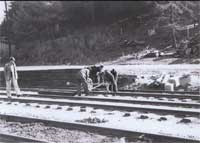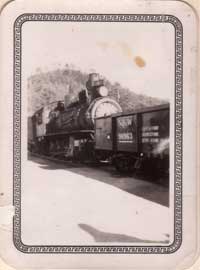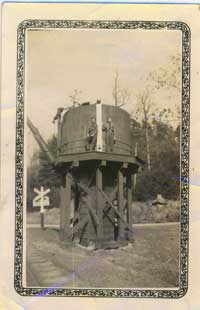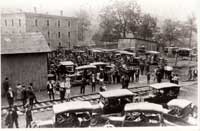For thirty-two years in the early 1900s, folks in Bland County had a taste of what other people had experienced for several years before. From 1914 to 1946, a railroad track stretched from Narrows to Suiter, Virginia. The railroad helped create new jobs, citizens were able to sell their goods to distant markets, and it was a gateway to other parts of Virginia.
At the turn of the century, Narrows was in need of a new industry to stimulate its economy. In 1903, Lees and McVitty of Salem, Virginia agreed to build a tannery. Tan bark from white oak and hemlock would be used to tan leather. At that time, the largest industry in Bland and Giles County was timber. Therefore, Lees and McVitty constructed three miles of railroad track up Wolf Creek to haul timber to the tannery.
New River, Holston, and Western Railroad Company continued the railroad all the way to Rocky Gap in 1912. This came about because of a purchase by W.M. Ritter Lumber Company called Buck Horn Timber. The railroad was built to Suiter in 1914, when Mr. W.E. Mingea, Jr., of Abingdon, Virginia, owner of all the big survey in Bland County, built it to help the lumber and bark industry. In 1919, it was sold to Norfolk and Western Railroad Company.
During the railroads first several years, the train ran five days a week. After much of the timber was hauled out it reduced its run to three days a week. The trains hauled an assortment of goods including cattle and sheep, manganese, general freight, and the mail. Gene Davidson said, "For the holidays ... we shipped turkeys. Usually went to Pennsylvania, Philadelphia. We picked the turkeys, bled them, and I don't think we dressed them." He also remembered his family receiving living room furniture from a mail order catalog by the railroad.
The train also pulled one passenger car. Mrs. Mabel Pruett used to ride the train home from boarding school. She said, "Well, it was always exciting to ride the train, and to stop at the stations and see the people that came to meet the trains." There were twelve stations from Narrows to Suiter. Beginning from Narrows, they were: Talmash, Penvir, Bridge No. 2, First Ford, Chappel, Nidey, Round Bottom, Rocky Gap, Novis (South Gap), Hicksville, Bastian, and Suiter.
During the time the trains ran, there were two post offices on Wolf Creek. The post office at Round Bottom was managed by Booker Pilliam. He managed the post office and a small store there. Later, that post office was moved about four miles down to Nidey where it was managed by Bill Wonsley. Mrs. Pruett remembered that "most of the farmers would come down there to pick up the mail and stand there and talk for hours at a time.
With the advent of big trucks to the area, it became cheaper and easier to haul freight by truck and the train reduced its run to three days a week. The trains hauled an assortment of goods including cattle and sheep, manganese, general freight, and the mail. Gene Davidson said, "For the holidays ... we shipped turkeys. Usually went to Pennsylvania, Philadelphia. We picked the turkeys, bled them, and I don't think we dressed them." He also remembered his family receiving living room furniture from a mail order catalog by the railroad.
During the time the trains ran, there were two post offices on Wolf Creek. The post office at Round Bottom was managed by Booker Pilliam. He managed the post office and a small store there. Later, that post office was moved about four miles down to Nidey where it was managed by Bill Wonsley. Mrs. Pruett remembered that "most of the farmers would come down there to pick up the mail and stand there and talk for hours at a time.
With the advent of big trucks to the area, it became cheaper and easier to haul freight by truck instead of train.
Stephanie Hamilton class of 1993
